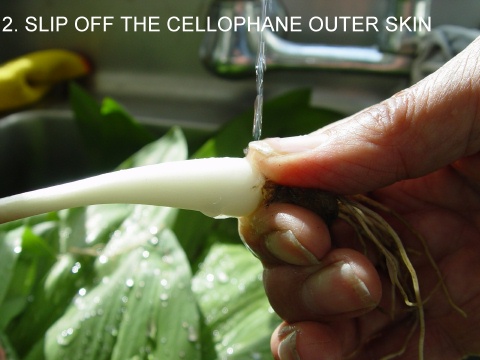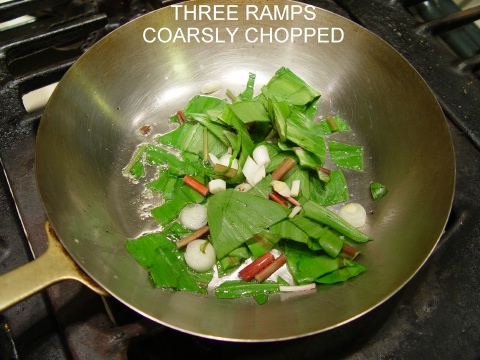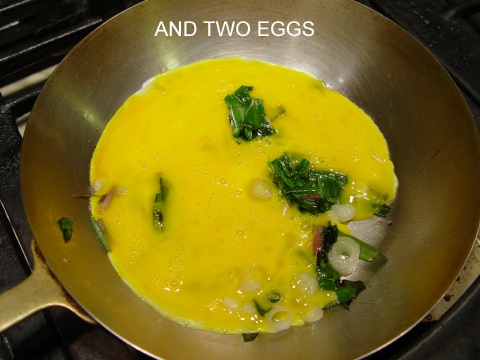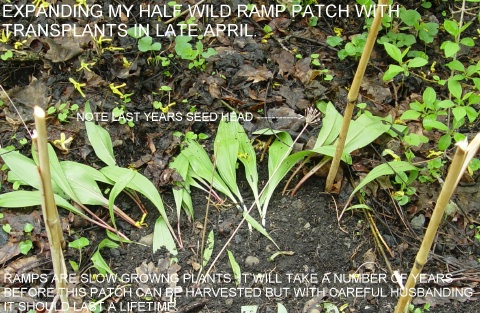Ramps – finding, picking, cooking (and planting!)
Not in the back yard, actually. They’re in the utility area behind the back yard, about 20 feet from the compost heap. The little patch is no more than 30 inches from the path, but it hid in plain sight until a couple of years ago, when Bill the forager added ramps to his must-find collection.
Each year he spends more time tracking them down and eating them up, and now he’s written a guest post guide to them. All I can say is buckle your reading glasses – major ramp treatise ahead.
HALF-WILD GREENS Part I: RAMPS (Allium tricoccum)
I grew up knowing the glory of greens.
Before Clarence Birdseye and the magic of flash freezing, spring greens were the first fresh vegetables available to most of us. Even though my grandmother ran a grocery store and had one of the few freezers in Washington, PA, it was always my grandfather, knife in hand, who would scour the yards and fields for dandelions and bring the first greens to table.
He loved to sauté them in olive oil with a little crushed pepper, mix in a few scrambled eggs, and enjoy them with crusty toast and black coffee. He could do this morning, noon and night if grandma would let him.
They were prosperous, self made Italian immigrants. Their store was on the south side of town, at the intersection of Park Avenue and Main Street. Little by little grandma’s financial skills allowed them to buy nearby houses and land as the properties came on the market.
The house I lived in as a child was purchased from the Hazel-Atlas glass factory during one of the plant expansions and moved across the street, onto an empty lot where granddad and a friend originally had their garden plot.
At times I would accompany my grandfather as he collected greens. It was from him that I learned about water cress and came to gather and market it for our store and several others in the neighborhood.
By this time my grandparents and another family member were able to purchase, for the princely sum of $3,000, a 64 acre farm on the edge of town only a few blocks from the store and our house. This is where I came to learn about the land and the virtues of loosing myself in nature.
It is said that first (or only) born children tend to be very comfortable being alone. I certainly made the most of the farm and surrounding forests coming to know nature well and coming easily and naturally to the world of foraging.
As I say, I grew up knowing well the glory of greens, and yet somehow never collected ramps. I doubt that they were missing from the limestone hills of southwest Pennsylvania, and I knew my Italian grandparents loved both greens and garlic, so it is a bit of a mystery to me as to why and how they were absent from my early foraging experience.
Of course I had heard of ramps, knowing they were a springtime staple of southern Appalachian rural folk. Medicinal too, I had heard, probably in the same way that almost any springtime green is to those who suffer the long winters without fresh vegetables. In Pennsylvania it was not only dandelion and water cress, but also mustards and lambsquarter that filled the bill for a spring tonic and cleanser.
Even as an adult I thought ramps were restricted to areas well below the Mason-Dixon Line. I now know better and have Ken Kleinpeter to thank for correcting me. (Ramps grow from Alabama nearly to the Arctic.)
Ken is a Louisianan by birth, a long time sheep tender, cheese maker, dairyman, and now farm manager for Glynwood Estates, near Fahnstock Park in the Hudson Valley of New York. A few years ago as he and I went out looking for morels, he mentioned collecting ramps near the farm he manages, and he pointed them out to me several times during the day as we roamed the back roads searching for likely looking morel habitats.
By the end of the day we had collections of both morels and ramps in our baskets. At the dinner table it was hard to tell which one was better, and I was convinced that for all of those years prior I had been missing out on a great deal.
It was only after this trip with Ken that I noticed the ramps growing in my own back yard. I have been on the lookout for them in other places ever since. Here is what I have discovered.
HUNTING FOR RAMPS
In the Hudson Valley ramps do not seem to be terribly common, but when I find them they are often locally abundant. This may be due to the fact that they have not been widely collected in the places where they grow so I am quite careful to take only a few from each place I find them, leaving the rest to grow and spread their seed.
Ramps are very slow growing and in places where heavy collecting has occurred it has taken many years for the population of plants to recover. Collection of ramps in the Smoky Mountain National Park, for example, was banned in 2002 for just this reason and is now being heavily regulated.
Ramps seem to be confined to deep hillside forests, often on a north facing slope, and on well shaded floodplains where there is ample organic material in the soil.
I have not found them in mucky soil, but transitional areas of sandy loam where the Skunk Cabbage meets the Trout Lily seem to be areas worth investigating. Quite often I also find Red Trillium, Dutchman’s Breeches, and Bloodroot scattered among the ramps.
Mature ramps will have two or three 2″ x 10″ shiny green leaves arising from a common purplish stem which fades underground into a white elongated bulb; The deeper the soil, the deeper the bulb. Some in sandy flood plains will have their roots six to eight inches below the surface.
Ramps tend to grow in clusters and will have a strong garlic odor. Once lifted from the soil an easy to peel, mucilaginous, cellophane-like sheath will be seen covering the stem base and bulb.
In the mid-Hudson area, the green shoots will emerge from the soil in April, before the trees leaf out. A single flowering stem with a whitish ball of florets appears six weeks later as the tree canopy leafs out and closes over.
By this time the leaves of the ramps will have died back, their month long greening season over. The head of black seeds seem to be released in stages. Some can still be found in the straw-colored dried seed head in the spring of the following year.
The clustering habit of ramps seems to come primarily from the seeds. One can often find young ramps in slender almost thread-like sprays scattered here and there among the clusters of mature plants. Propagation from seed is difficult, as they require a prolonged, two-stage germination process, but is one way ramps are commercially cultivated.
LOOK-ALIKES
There are three or four plants which might be confused with ramps. Of these, the first two, Lily of the Valley and Trout Lily, like ramps, are small two – leafed members (or relatives) of the Lily Family.
Lily of the Valley (Convallaria majalis) is the relative recently moved from the Liliaceae to the Ruscacae. It stands more erect than ramps, rising from small pips in the early spring and forming dense colonies, members of which are connected by a fibrous underground network of rhizomes.
By the end of April the mature two-leaved plants will send up a single erect raceme of 10 to 15, usually white, bell shaped flowers. These will smell just like your Grandmothers Lily of the Valley Cold Cream.
There are many cultivars and although in the past it was used in traditional herbal medicine as both a cure for memory loss and as an aid to induce “common sense” all parts of this plant are now known to be highly poisonous.
Trout Lilly (Erythronium americanum) is also called Adders Tongue or Dog Tooth Violet. Like ramps it will often grow in spreading troops, with plants of varying size.
Young plants will usually have but one leaf whereas mature plants will usually have two. The leaves are much smaller than ramps (1″x 4″), are deeply mottled, and will often send up a single yellow nodding flower. Peterson lists it as edible but acknowledges it is also known to be an active emetic, inducing vomit.
Mature specimens of the Skunk Cabbage (Symplocarpus foetidus) would not be mistaken for ramps due to the large size of the ovate leaves, up to a foot in diameter. Young Skunk Cabbage, however, has 3″x 6″ leaves that more closely resemble the 2″ x 10″ elongated leaves of ramps.
The clearly veined leaves and ‘skunky’ odor of the crushed plant however will quickly serve to identify this fleshy herb which contains toxic calcium oxalate crystals.
One bite of this plant, even if well cooked, will cause the mouth and throat to burn and swell up. This is the same compound that makes the green parts of rhubarb and dumbcane (Dieffenbachia ) so poisonous.
Growing in the same location as Skunk Cabbage is False Hellibore (Veratrum viride) a quite toxic member of the Lilly family. It is much more robust than even Skunk Cabbage and quickly develops an erect stem with heavily ribbed, spirally arranged leaves. I can’t imagine anyone mistaking this plant for Ramps, but then again ‘common sense’ often presents itself as a toxic brew!
PREPARING RAMPS FOR THE KITCHEN
Ramps are very easy to prepare. Place them in a bowl of water and rinse the dirt from the roots. This will also loosen the membrane which covers the stem and bulb. Slide the membrane off, do a final rinse and you are done.
In the fridge they will store quite easily in a plastic bag, or loosely wrapped in a wet towel.
COOKING WITH RAMPS
A Google search will turn up dozens of ways to cook with these wild leeks. Some call for mixing them with scrambled eggs, as Grandpa Cario did with dandelion. Others recommend a simple potato-ramp soup.For the sophisticated there is Asparagus braised or grilled with Ramp Aioli.
Recipes galore await your search, more than you can possibly attempt in the short season when Ramps are available.
My favorite, and perhaps the easiest, is to coarsely chop the greens along with the bulbs and sauté in olive oil. You can play around, adding perhaps a garlic clove or shallot, thinly sliced red Bell Pepper, or a sprinkling of red pepper flakes. When done, toss with pasta or serve over grilled vegetables.
You can’t go wrong. The complex flavor is subtle yet intense, sweetish on the tongue with lots of garlic in the nose. Down south it is said that if you eat them alone, you will stay alone for no one will want to be near you. The solution to this is simple, dine together and rinse with a soft red wine.
CULTIVATING RAMPS
Since the ramps grow wild in my back yard, I have taken to expanding this local crop by transplanting a few plants with each collection I make from the wild.
These have been planted only in the very shady parts of the yard, the tree-lined margins where conditions are similar to those in the deep forest.
Studies conducted by plant scientists indicate that the seeds normally need two seasons to fully germinate, that planting the seeds in the fall usually produces better results than spring planting, and that amending the soil with calcium increases the vigor and eventual harvest of the plants.
A quick planting guide may be found here. For a more detailed booklet and source for seeds and bulbs click here.
Much like planting asparagus, this is a gardening exercise for the future. Anticipation, patience and prudence are the names of the game.
If you need results more quickly, consider the cultivation of half-wild lambsquarter, details coming in part 2 of this series.

































Loved the info and especially the pics, as I’ve never seen ramps growing here in central MD. I was surprised that they were reddish along the stems and were actually so meaty and bulbous. We do have skunk cabbages and trout lilies though. (The latter are ephemerals that have a pretty yellow bloom and are up now and then completely gone by May.)
Do you have any info on whether ramps would grow in central MD woodland?
What a terrific article! I only recently learned to identify skunk cabbage, so now I must look to see what lives “next door”–though I doubt, given my novice status, I would hazard plucking out what I think is ramp just yet (anyway, not without sending a picture or sample to you neighbors to confirm)! Of course, I love the Louisiana connection, given our recent trip. And I look forward to part 2–I remember when I was introduced to lambsquarter as an edible green, not just a weed, when our neighbor on Long Island, who was a long-time organic gardener, pointed it out to us one day. At winter’s end, there are few things that can match the thrill of coming upon the first spring greens!
Thanks so much for this splendid article on ramps Bill. We don’t have them here in the Pacific Northwest but I found a Canadian website that sells both the bulbs and seeds. I passed the information on to my Grandson who is just planting the family’s Spring garden and look forward to trying this new addition to the onion family!
So loved the article and just went to the Ramps Festival in Robbinsville, NC – it was great – how about more recipes??
Welcome, Dawn,
So glad you enjoyed the article – and the festival! Did you pick up any good ramp tips or recipes there?
We’ll be having a new (old) ramp dish for dinner tonight, so the recipe will be appearing very soon.
Leslie
Thank you so much for posting this valuable information! The side-by-side comparisons of ramps and their poisonous look-alikes was very helpful, as I was most concerned about confusing ramps with lily-of-the-valley. That’s neat too that they often grow near trillium- that was certainly the case where I found them. And thanks for sharing the recipe ideas, and your efforts to expand the ramp patch. Now knowing how long it takes for them to propagate, I might like to try this too (and will certainly be careful about harvesting them sustainably in the wild). Thanks again for all the great info!
Hi Karen,
Thanks for the compliments and the specific references to the trillium and the poisonous look alikes. Bill will be happy to know that information is proving useful. Good luck with propagating — we’ve had only small success, but we have had some!
I cannot even tell you how immensely helpful this post was: I just found my first two patches or ramps, entirely because of your description of where they might be and what other plants would be around them. First I saw the trout lilies, then the red trillium, and then…ramp patches! I was very careful about harvesting them and only took as much as I knew I would eat, but I’m so excited to have found them at the park where I hike with my dog. Thanks for such precise information.
Welcome, Mara.
I’m delighted to hear the advice was useful, both for finding and for careful harvesting. Dog walking aspect does prompt a warning I hadn’t thought to offer before – and which probably needs no further explication. It’s something I always think of when discussing the deliciousness of dandelions, but I’d never thought of it with ramps. Might be best to avoid those growing very near the paths in parks that are dog-friendly!
The name for this plant (allium tricoccum)in the language of the Miami and Illinois tribes was mispronounced by the French as “Chicagou,” and the city at the tip of Lake Michigan was named after it. Ramps were rife in Chicago originally, but are found now only in a few spots, which I will not name.
Thanks for the etymological tidbit, Steve, and for your discretion in the matter of modern ramp location (Big city, whole lotta food lovers).
Hey Steve,
When do the ramps start sprouting in northern Illinois?
Thanks
Is it possible to find ramps in the sierra nevada foothills in california? Or if I ordered some sets, would they grow here. We have very cold temps, including lite snow from dec-may.
Thanks.
Hi Kate,
The answers to your questions are “no” and “maybe yes”. From all I’ve been able to find out, ramps don’t grow wild any farther west than the eastern parts of the Dakotas. But that doesn’t mean you couldn’t cultivate them from purchased stock. If conditions are right – which it sounds as though they might be – I don’t see why ramps wouldn’t do fine. Certainly worth a try!
I live in the New York City. Is there anyplace that sells them?
Hi Lynne, I’m pretty sure they’re sold – at least occasionally – at the Union Square Greenmarket, and they may well be at other greenmarkets as well. Other than that, I don’t know, but if they’re at a semi-high end grocery in Poughkeepsie it seems likely they’d be at the tonier groceries down there, too.